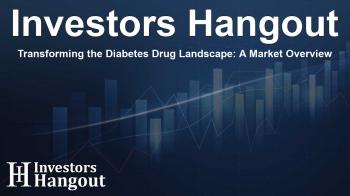Transforming the Diabetes Drug Landscape: A Market Overview

Understanding the Diabetes Drug Market
The diabetes drug market is experiencing a remarkable transformation, driven by an increasing global prevalence of diabetes and advancements in treatment options. As of recent studies, the market was valued at around USD 79.4 billion and is projected to surge to USD 145 billion by 2032. The anticipated growth rate is a healthy 6.9% CAGR from 2024 to 2032. This trajectory is primarily influenced by the rising burden of diabetes, especially Type 2 diabetes, alongside continuous innovations in drug therapies.
Key Factors Driving Market Growth
The diabetes drug market is largely fueled by several key factors. Firstly, the rapid rise in diabetes cases globally calls for more effective treatments. According to the latest numbers, over 537 million adults were diagnosed with diabetes, and that figure is expected to soar to 783 million by 2045, partly due to lifestyle choices and increased life expectancy.
Moreover, healthcare expenditures in diabetes care are on the rise, equipping patients with better access to necessary medications. Companies are investing heavily in research and development for new therapies, ensuring that the market remains dynamic and responsive to changes in patient needs.
Market Segmentation Insights
The diabetes drug market can be segmented into various categories including drug class, route of administration, diabetes type, and distribution channel. Notably, the GLP-1 receptor agonists segment has captured the largest revenue share. Popular medications like Ozempic and Rybelsus are often preferred for their dual benefits in managing blood sugar levels and aiding weight loss.
In terms of diabetes type, Type 2 diabetes commands the highest market share, reflecting the high incidence rates. Retail pharmacies are currently leading the distribution channel, benefiting from their accessibility and variety of available treatment options.
Competitive Landscape and Major Players
Several major pharmaceutical companies are dominating the diabetes drug market, including Novo Nordisk, Eli Lilly, and Sanofi. These companies are at the forefront of developing innovative medications that not only improve patient adherence but also provide efficient blood sugar control.
- **Novo Nordisk A/S** offers popular treatments such as Ozempic and Rybelsus.
- **Eli Lilly and Company** has made strides with Mounjaro and Trulicity.
- **Sanofi** continues to release effective options like Lantus and Toujeo.
- **Merck & Co., Inc.** includes medications like Januvia and Janumet in its portfolio.
- **AstraZeneca** supports patients with Farxiga and Bydureon.
Innovations and Recent Developments
The past few years have seen significant innovations within diabetes care. For instance, there have been breakthroughs in drug delivery methods such as needle-free injectors, enhancing patient convenience. The recent FDA approvals for medications for pediatric use have also been a game-changer, widening access to essential therapies for younger populations.
Moreover, burgeoning initiatives like the Healthy China 2030 plan underscore the commitment to combatting diabetes while promoting accessible healthcare solutions.
Regional Market Analysis
Geographically, North America remains the largest revenue contributor to the diabetes drug market, accounting for approximately 36% of total sales. This advantage can be attributed to a combination of high obesity rates, advanced healthcare systems, and strong investments in diabetes medication.
Interestingly, the Asia-Pacific region is emerging as the fastest-growing area, spearheading innovative diabetes care solutions. Countries like China and India are making concerted efforts to improve drug affordability and availability, driving greater access to treatment for millions.
Future of the Diabetes Drug Market
With the diabetes drug market poised for substantial growth, stakeholders must adapt to changing dynamics. Continuous research and the introduction of next-generation medications will be crucial in addressing the diverse needs of the population. As companies focus on developing comprehensive and effective treatment protocols, the future looks promising for diabetes care.
Frequently Asked Questions
What is the projected size of the diabetes drug market?
The diabetes drug market is expected to grow to USD 145 billion by 2032.
Which drug class holds the largest market share?
GLP-1 receptor agonists hold the largest revenue share among drug classes.
What factors are driving the growth of the diabetes drug market?
The increase in diabetes cases and innovations in medication are key drivers of market growth.
Who are the major players in the diabetes drug market?
Major players include Novo Nordisk, Eli Lilly, Sanofi, and Merck & Co., Inc.
Which regions are showing the fastest growth in the diabetes drug sector?
The Asia-Pacific region is currently experiencing the fastest growth in this sector.
About The Author
Contact Hannah Lewis privately here. Or send an email with ATTN: Hannah Lewis as the subject to contact@investorshangout.com.
About Investors Hangout
Investors Hangout is a leading online stock forum for financial discussion and learning, offering a wide range of free tools and resources. It draws in traders of all levels, who exchange market knowledge, investigate trading tactics, and keep an eye on industry developments in real time. Featuring financial articles, stock message boards, quotes, charts, company profiles, and live news updates. Through cooperative learning and a wealth of informational resources, it helps users from novices creating their first portfolios to experts honing their techniques. Join Investors Hangout today: https://investorshangout.com/
The content of this article is based on factual, publicly available information and does not represent legal, financial, or investment advice. Investors Hangout does not offer financial advice, and the author is not a licensed financial advisor. Consult a qualified advisor before making any financial or investment decisions based on this article. This article should not be considered advice to purchase, sell, or hold any securities or other investments. If any of the material provided here is inaccurate, please contact us for corrections.

